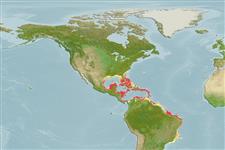>
Ovalentaria/misc (Various families in series Ovalentaria) >
Pomacentridae (Damselfishes) > Microspathodontinae
Etymology: Microspathodon: Greek, mikros = small + Greek, spatha = spathe + Greek, odous = teeth (Ref. 45335).
More on author: Cuvier.
Environment: milieu / climate zone / depth range / distribution range
นิเวศวิทยา
เกี่ยวกับทะเล,น้ำเค็ม เกี่ยวกับหินโสโครก; ไม่มีการอพยพย้ายถิ่น; ระดับความลึก 0 - 120 m (Ref. 10797), usually 0 - 10 m (Ref. 7247). Subtropical; 33°N - 25°S, 98°W - 34°W
Western Atlantic: southern Florida (USA) and Bermuda through the Caribbean Sea to Brazil (Ref. 40101).
ขนาด / น้ำหนัก / Age
Maturity: Lm ? range ? - ? cm
Max length : 21.0 cm TL เพศผู้/กระเทย; (Ref. 9710); common length : 15.0 cm TL เพศผู้/กระเทย; (Ref. 3139)
Short description
เครื่องมือที่ใช้ในการแยกชนิดสัตว์,สิ่งมีชีวิตออกจากกัน | สัณฐานวิทยา | ความยาวต่างๆ
เงี่ยงครีบหลัง (รวม) : 12; ก้านครีบอ่อนที่หาง (รวม) : 14 - 15; เงี่ยงครีบก้น: 2; ก้านครีบอ่อนที่ก้น: 12 - 13. Tail bright yellow. Juveniles dark blue with transparent tail and electric blue spots on side (Ref. 26938). Adults dark yellowish brown, the edges of the scales darker (Ref 13442).
A common (Ref. 9710) territorial species that inhabits coral reefs, juveniles usually encountered among branches of yellow stinging coral, Millepora. Adults are found in very shallow waters of coral reefs, usually near top of outer edge where there are caves, holes, and abundant fire coral (Ref. 26938). Feed primarily on algae but also on polyps of fire coral (Ref. 3139) and other invertebrate animal material (Ref. 13442). Juveniles occasionally pick parasites from other species of fish (Ref. 3139). Oviparous, distinct pairing during breeding (Ref. 205). Eggs are demersal and adhere to the substrate (Ref. 205). Males guard and aerate the eggs (Ref. 205). Occasionally marketed fresh (Ref. 3139). Have been reared in captivity (Ref. 35420).
Life cycle and mating behavior
วัยเจริญพันธุ์ | การสืบพันธุ์ | การวางไข่ | เซลสืบพันธ์ของเพศเมีย(ไข่) | ความดกของไข่ | ตัวอ่อน
Oviparous, distinct pairing during breeding (Ref. 205). Eggs are demersal and adhere to the substrate (Ref. 205). Males guard and aerate the eggs (Ref. 205).
Allen, G.R., 1991. Damselfishes of the world. Mergus Publishers, Melle, Germany. 271 p. (Ref. 7247)
IUCN Red List Status (Ref. 130435: Version 2024-1)
Threat to humans
Harmless
Human uses
การประมง: การประมงยังชีพ; สถานที่แสดงสัตว์และพืชน้ำ: การค้า
เครื่องมือ
Special reports
Download XML
แหล่งที่มาจากอินเตอร์เน็ต
Estimates based on models
Preferred temperature (Ref.
123201): 26.1 - 28.2, mean 27.5 °C (based on 702 cells).
Phylogenetic diversity index (Ref.
82804): PD
50 = 0.5625 [Uniqueness, from 0.5 = low to 2.0 = high].
Bayesian length-weight: a=0.02239 (0.01256 - 0.03989), b=3.02 (2.86 - 3.18), in cm total length, based on LWR estimates for this species & (Sub)family-body (Ref.
93245).
ระดับชั้นอาหาร (Ref.
69278): 2.1 ±0.1 se; based on diet studies.
ความสามารถในการกลับคืนสู่ปกติ (Ref.
120179): ขนาดกลาง, เวลาต่ำสุดที่จะทำให้ประชากรเพิ่มขึ้นเป็น 2 เท่าใช้เวลา 1.4 - 4.4 ปี (Preliminary K or Fecundity.).
Fishing Vulnerability (Ref.
59153): Low vulnerability (11 of 100).
Nutrients (Ref.
124155): Calcium = 44.9 [18.7, 74.8] mg/100g; Iron = 0.645 [0.367, 1.193] mg/100g; Protein = 18.7 [17.4, 19.9] %; Omega3 = 0.166 [0.091, 0.301] g/100g; Selenium = 17.6 [8.0, 37.8] μg/100g; VitaminA = 37.2 [7.7, 166.9] μg/100g; Zinc = 1.07 [0.66, 1.70] mg/100g (wet weight);
